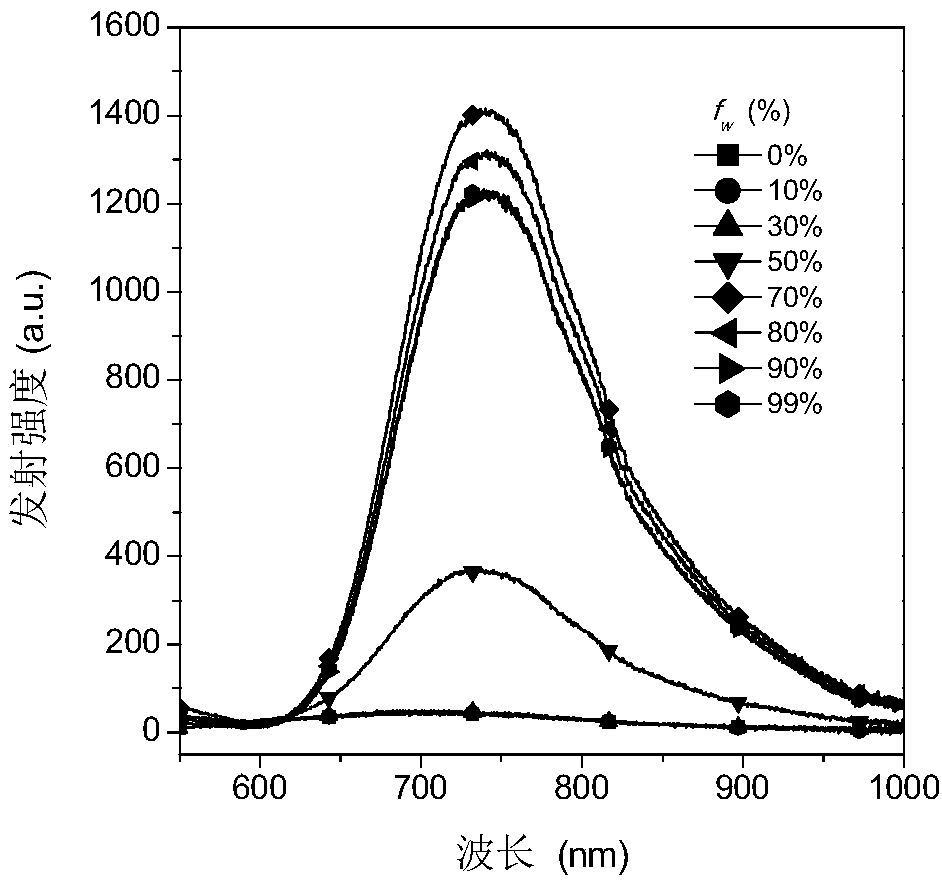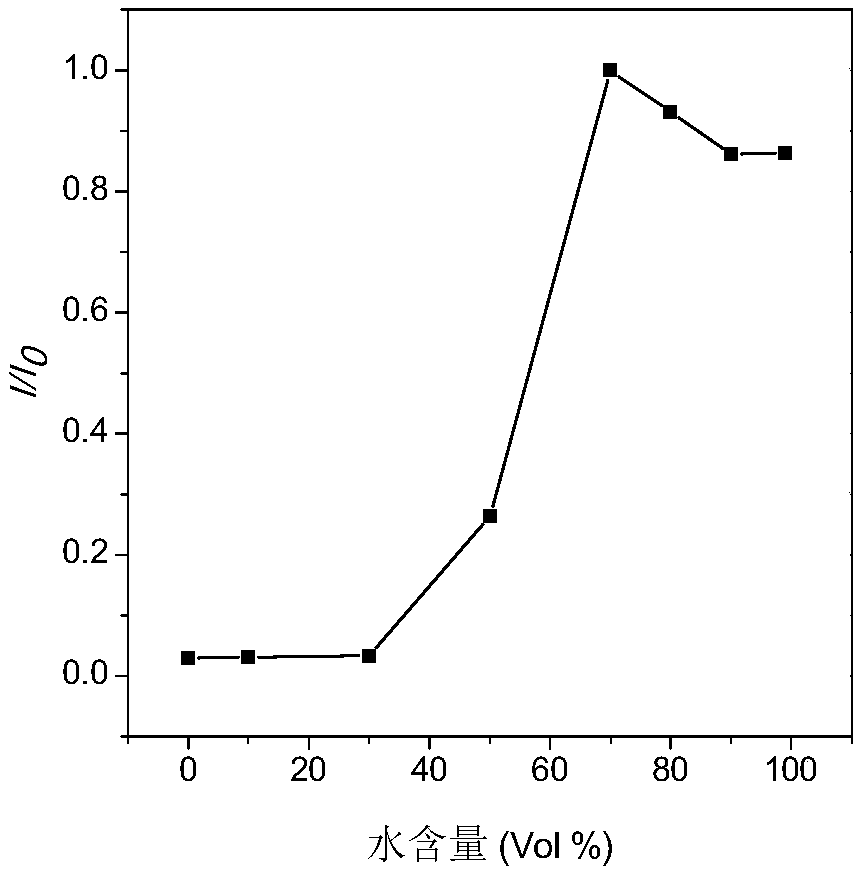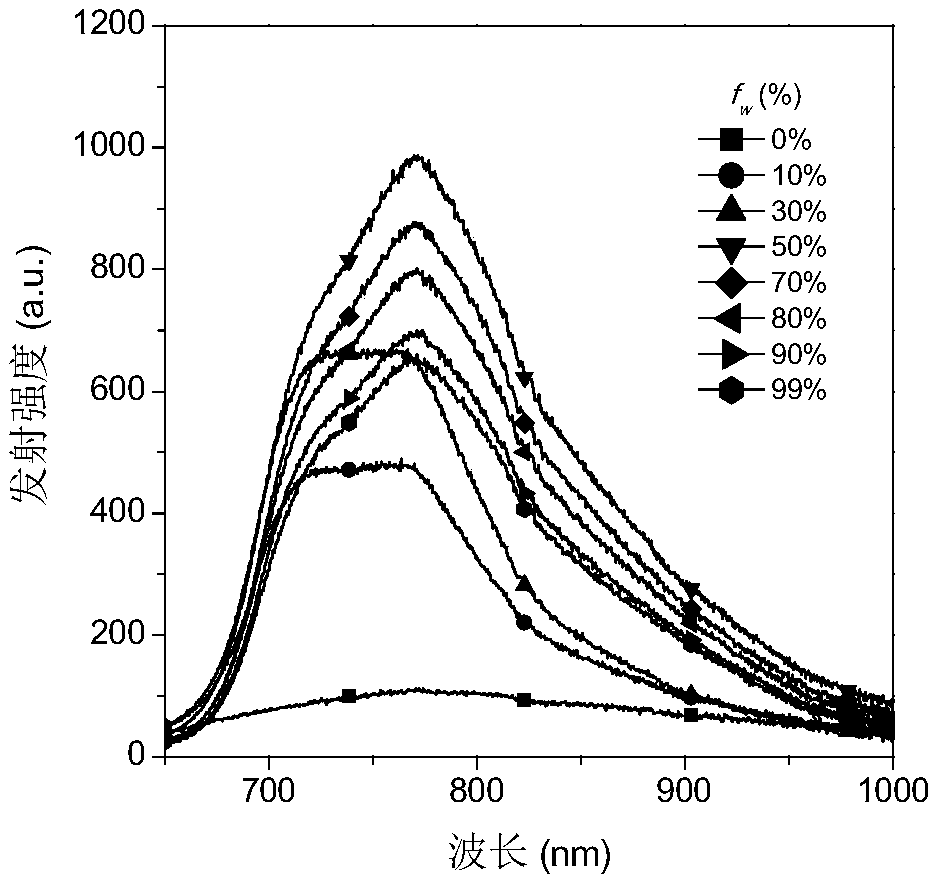Aggregation-induced emission type near-infrared fluorescent material and synthesis method thereof
A technology for aggregation-induced luminescence and fluorescent materials, applied in the field of preparation of the materials
- Summary
- Abstract
- Description
- Claims
- Application Information
AI Technical Summary
Problems solved by technology
Method used
Image
Examples
Embodiment 1
[0046] 1. 1.5mL (13.4mmol) m-aminoanisole, 8.76g (40.2mmol) 4-methyl iodobenzene, 7.5g (67mmol) potassium tert-butoxide, 483mg (2.68mmol) o-phenanthroline, 510mg ( 2.68mmol) cuprous iodide was added in 20mL toluene, stirred and reacted at 125°C for 20 hours, filtered and spin-dried the filtrate, dry column chromatography (the mixed solution of petroleum ether and ethyl acetate volume ratio of 100:1 was eluent), to obtain the compound of formula I.
[0047]
[0048] 2. Dissolve 1.74mL (18.4mmol) of boron tribromide in 18mL of dichloromethane, and add 3.72g (12.26mmol) of the compound of formula I in dichloromethane, and stir and react at room temperature for 12 hours. The reaction solution was poured into ice water, extracted with deionized water and dichloromethane, and a mixture of petroleum ether and ethyl acetate with a volume ratio of 30:1 was used as the eluent) to obtain the compound of formula II.
[0049]
[0050]3. Add 6.8mL (88.5mmol) N,N-dimethylformamide to ...
Embodiment 2
[0060] In this example, malononitrile in Example 1 was replaced with an equimolar amount of the compound of formula VI, and the other steps were the same as in Example 1 to obtain the fluorescent dye shown in V-2 with a yield of 75%.
[0061]
[0062] The structural characterization data of the resulting product are: 1 H NMR (300MHz, CDCl 3 )δ8.65(s,1H),7.71-7.55(m,5H),7.38(d,J=8.8Hz,1H),7.15(dd,J=27.4,8.2Hz,8H),6.93(s,1H ),6.82(dd,J=8.8,2.2Hz,1H),6.66(d,J=2.1Hz,1H),2.37(s,6H).
[0063] The formula VI compound used in the present embodiment is prepared according to the following method:
[0064] Add 1g (5mmol) of α-bromoacetophenone, 427mg (5mmol) of cyanoacetic acid, 201mg (5mmol) of sodium hydroxide, and 3.9mL of deionized water into 18mL of ethanol, and react under reflux for 1 hour, cool to precipitate a solid, and filter to obtain Compound of formula VI.
[0065]
Embodiment 3
[0067] In this example, malononitrile in Example 1 was replaced with an equimolar amount of the compound of formula VII, and other steps were the same as in Example 1 to obtain the fluorescent dye shown in V-3 with a yield of 67%.
[0068]
[0069] The structural characterization data of the resulting product are: 1 H NMR (300MHz, CDCl 3 )δ7.97-7.82(m,2H),7.43(d,J=16.1Hz,1H),7.32(d,J=8.9Hz,1H),7.16(dd,J=29.3,8.3Hz,8H), 6.82(dd,J=8.8,2.2Hz,1H),6.67(d,J=2.0Hz,1H),2.38(s,6H),1.72(s,6H).
[0070] The compound of formula VII used in this embodiment is prepared according to the following method:
[0071] Add 3.2mL (30mmol) of 3-hydroxy-3-methyl-2-butanone, 5.9g (90mmol) of malononitrile, and 3.8g (34mmol) of magnesium ethoxide into 30mL of ethanol, and react at 60°C for 8 hours. The reaction solution was spin-dried and then subjected to dry column chromatography (using a mixture of petroleum ether and ethyl acetate at a volume ratio of 20:1 as the eluent) to obtain the compoun...
PUM
 Login to View More
Login to View More Abstract
Description
Claims
Application Information
 Login to View More
Login to View More - R&D
- Intellectual Property
- Life Sciences
- Materials
- Tech Scout
- Unparalleled Data Quality
- Higher Quality Content
- 60% Fewer Hallucinations
Browse by: Latest US Patents, China's latest patents, Technical Efficacy Thesaurus, Application Domain, Technology Topic, Popular Technical Reports.
© 2025 PatSnap. All rights reserved.Legal|Privacy policy|Modern Slavery Act Transparency Statement|Sitemap|About US| Contact US: help@patsnap.com



